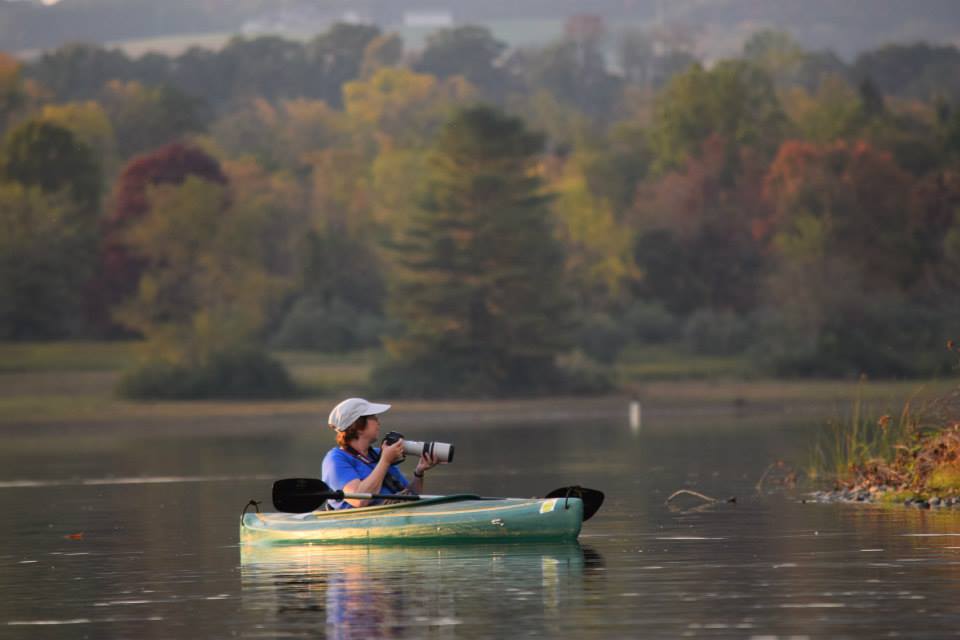
Some tips for doing bird photography!
My set up: I use the Canon 7D Mark II with a 400mm fixed lens. Due to weight restrictions on my tired shoulders, this is an ideal set up for me that I can carry around for hours, use in the kayak, or from the car. The Canon 100-400mm lens would be even better, but is too heavy for me.
The Canon 7D Mark II is a crop sensor camera which is preferred by birders because it effectively increases the focal length of the telephoto lens. For example, my 400 mm lens gives me close to 600mm focal length.
My settings: Aperature Priority with a wide open F-stop, which gives me a blurred background. I may bump the F-stop up a notch or two in order to make sure the entire bird is in focus, especially with a larger bird like a heron. Spot focus, AI Servo, medium burst speed which gives me several frames per second. Use a high enough ISO to get a fast shutter speed (1000+ if possible). Check exposure compensation and adjust, especially if shooting into the sky.
Tip #1: Using a tripod isn’t necessary most of the time. If you’re fairly steady and light is good enough for a fast shutter speed, don’t bother! Keep your arms close to your body, with your left hand bracing the base of your camera and lens. Use the door frame of your car or a tree to steady yourself if you’re waiting for action.
Tip #2: The car makes a great bird blind. Drive the back roads where there is little traffic. Use your ears as well as your eyes to find wildlife. Look ahead beside the road for perched birds or quiet animals. Pull over before you get too close. Use your flashers if necessary. Turn off the car engine to prevent vibration when shooting from the car.
The kayak also works well for nature photography. Most birds with the exception of ducks will let you get close and observe them doing their thing if you don’t make sudden movements. You may see warblers and sparrows working the edges of the lake, and herons and egrets hunting for prey. For some reason they don’t seem to recognize you as a threat, or as a human, when sitting in a kayak.
Tip #3: Take a lot of shots. You don’t know which one will show something surprising. Don’t miss that shot when the bird flips the fish into the air to catch it head first for swallowing!
Tip #4: When there’s a “crow party” or a disturbance, pay attention! There’s a predator and some interesting photos to be had.
When out birding, I use my ears as much as my eyes. I know the bird songs and calls. When there’s a cacophony of screaming birds, there’s a reason! It pays to check out what the enemy is: an owl? A Cooper’s Hawk? A snake? Photos that tell a story are always more interesting than just a perched bird.
Tip #5: Be Ready! This is the most important piece of advice that can be given. Nature Photography is unlike other kinds of photography because you can’t make appointments with your subject, and you can’t pose them when you do find them—so you must be ready when an opportunity presents itself. It won’t last long!
Tip #6: The long lens works well in the garden–almost like a Macro for bugs, bees, dragonflies and hummingbirds.
Tip #7: Light is everything! Get the light behind you as much as possible to avoid shadows. Keep the subject completely in the sun or in the shade. Early in the morning and late in the afternoon or evening (the golden hour) is the best light for nature photography. Overcast days are fine, too, if you can still get a good shutter speed.
Tip #8: Get out there and shoot everyday if possible. There is always something worth discovering. It’s exciting to go out looking for nature, because you have no idea what you will find. When I leave the driveway, my camera is always right beside me, ready for use. I live on a country road, and I’m always looking for action—a hawk perched in a tree or doing aerial battle with another raptor close by, a fawn hiding beside the road, a singing Indigo Bunting, etc.
Tip#9: Get to know your own “patch,” and what lives there. For me, it’s the intersection at the bottom of our hill, with the creek beside our country road. I know the Kingbirds that nest there, the resident Yellow Warbler, and the pair of Brown Thrashers. There’s often action there, and I like to pull over, turn off the engine, and watch and listen for opportunities. I have a couple of other back roads I visit almost every day also.
Tip #10: Avoid distractions in your photo—shadows, twigs, something in the background, another creature (bird, bee, animal). Keep it simple and uncluttered if you can. If you can step to the right or left to get rid of the distraction, then do it.
Tip #11: Use the rule of thirds when cropping your photos.